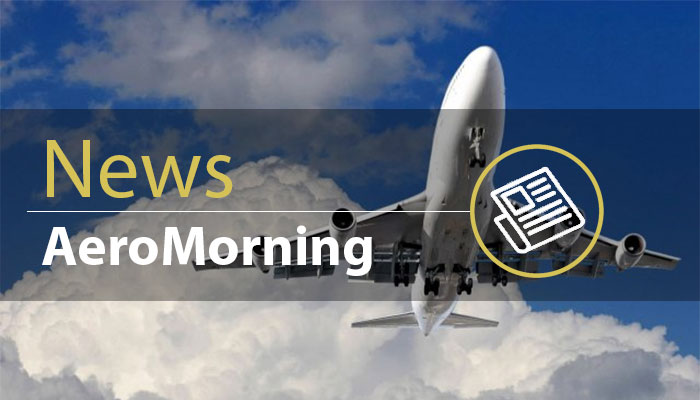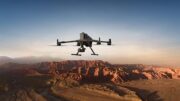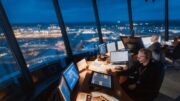Drone Surveillance Market: Remodeling the Future of Security
The U.S. Federal Aviation Administration (FAA) projected that have more than 858,000 commercial drones by 2026, while almost 433,407 commercial drones were already registered in 2025. Governments are also releasing stricter norms regarding surveillance not only at borders but also for power plants, airports, and utility centers. A strong instance came from the 2020 Tokyo Olympics that served as a case study of drone use for recreational purposes. Moreover, around 1,824 Intel drones with high-definition LED lights were deployed to perform a synchronized light show during the opening ceremony, representing global unity and the Olympic logo. These real-world uses highlight a clear shift: surveillance is no longer confined to ground personnel or fixed cameras; it is increasingly airborne, autonomous, and intelligent.
As regulatory bodies encourage the safe integration of drones and as industries adopt AI-driven surveillance, the Drone Surveillance Market is moving from an emerging niche to a mainstream necessity. In this blog, we’ll investigate all the probable factors and figure out why the industry is one of the most promising areas for future investment.
Drone Surveillance: Evolving Security Across Industries
Drones are no longer just a tool to capture photos and videos; they’re a primary and integral part of security in various industries. Surveillance drones are becoming more potent with the employment of AI-enabled analytics, real-time communications, and advanced sensors. Let’s go through how they are strengthening the security game in different industries.
1. Defense & Aerospace
Defense has been one of the earliest adopters of drone surveillance. Military forces around the globe are using unmanned aerial vehicles (UAVs) for border patrol, reconnaissance, and monitoring conflict zones. The U.S. Department of Defense in 2024 expanded its contract with Skydio, an American drone maker, to supply AI-driven drones for tactical surveillance. This shows how governments see drones not just as option, but as essential for modern aerospace and defense operations. Also, Ukraine has incorporated AI-enabled drone swarms, that are autonomous groups of drones capable of self-coordination to carry out surveillance and strike tasks. These are
developed by Swarmer and have been used over 100 times in combat, marking a key milestone in the use of autonomous drone technology in active warfare.
2. Law Enforcement & Homeland Security
Homeland security and police now deploy surveillance drones to investigate a crime scene, monitor mayhem, and even for search operations. To monitor large public events like football matches or concerts, the UK police is taking the help of surveillance drones for better security. Homeland security agencies in the U.S. also use drones to patrol critical infrastructures such as airports and ports. No blind spots with the use of modern surveillance drones. Additionally, in July 2025, New York City formed a Drone Operations Committee to expand drone use in public safety—tracking terror threats, protests, natural disasters, and capturing incidents like subway surfing. The NYPD’s technical drone program recently reached its 200th subway surfing arrest.
3. Telecom and Infrastructure Operators
Telecom giants and operators are using surveillance drones to check towers, pipelines, and railways. The conventional way of inspection can be time-consuming, costly, and risky, but deploying drones is much more convenient. For example, E& UAE introduced an autonomous drone-based cell tower inspection powered by AI in May 2025. Also, Centinus launched BOLO AI at Commercial UAV Expo in September 2025, which is not just a drone; it’s a proactive investigative tool with new technology.
4. Commercial Industry
Commercial sectors include various other fields like utility, logistics, energy, mining, and many more, and each field is employing surveillance drones for better safety and efficiency. Drones now reach the most dangerous areas of mining, where human interventions can be risky. Energy companies like Shell have been using drones to check oil and gas pipelines for leaks, a job that earlier required hours of manual checks. In logistics, Amazon’s testing of Prime Air is not only about delivery, but also about using drones for facility monitoring and site security.
5. First Responders & Public Safety
Drones have completely changed the way fire departments and disaster control departments used to work. They provide aerial images beyond Visual Line of Sight (BVLOS) that help first responders plan rescue operations better. According to a recent news Flying Lion, Inc. employed 55,773 DFR flights by the end of 2024, and amongst them, 35,000 were flown BVLOS. This adoption is only set to grow as climate challenges increase and emergencies. Additionally, PPB
launched drones as first responders from the roof of East Precinct in September 2025. The U.S. government is making higher deployment of first responder drones as they provide great assistance in emergency decision-making.
6. Private Security
Private security agencies, along with public security providers inclining more towards deploying surveillance drones for supervising large commercial properties, residential complexes, and even events. The security firms in Singapore are already using these drones to monitor industrial parks at night, which cuts ground patrol costs. Moreover, recently, the U.S. FAA has permitted a drone security business to operate autonomous patrol drones nationwide on business properties. In India, the Delhi police is also planning to purchase 32 surveillances drones to keep an eye on its 15 districts. These drones are equipped with real-time interaction systems and alarms that make private security even more powerful.
Why the Industry Presents a Profitable Investment Opportunity
Governments are looking for better and more convenient ways to tackle large gatherings and critical infrastructure. Surveillance drones are a more viable option for expanded and efficient monitoring than traditional surveillance systems like ground patrol or static cameras. Moreover, traditional surveillance systems, helicopters, and ground patrols are much costlier options, whereas drones provide an efficient solution even being cost-effective and flexible. The regulatory bodies in different regions, like North America, Europe, and some parts of the Asia Pacific, are coming up with norms to include drone surveillance in controlled airspace.
These regulations reduce investors’ hurdles by providing a promising landscape to invest in hardware manufacturing and services. Not only the government, even the public sectors are using drone surveillance for site visits, mining monitoring, logistics hubs, and agricultural farms governance. For instance, European energy companies adopted drones with AI-based analytics to monitor offshore platforms, reducing safety risks and downtime in 2024. These real-time deployments demonstrate that surveillance drones are not only changing but also enhancing and expanding the security systems.
Final Thought
As technologies evolve and we take steps towards having more capable sensors, AI-enabled analytics, and real-time interaction devices, drone surveillance is going to thrive in the future by providing more promising security advancements. Governments use them for better borderline
security, companies incorporate them for better safety and supervision, and smart cities deploy them to manage intricate urban problems. For investors, this is the best time to invest in this ever-rising industry. As the world is continuously moving towards digital and eco-friendly infrastructure, drone surveillance features an industry where innovation and profitability walk side by side.
Source: researchnester










Be the first to comment on "Drone Surveillance Market"